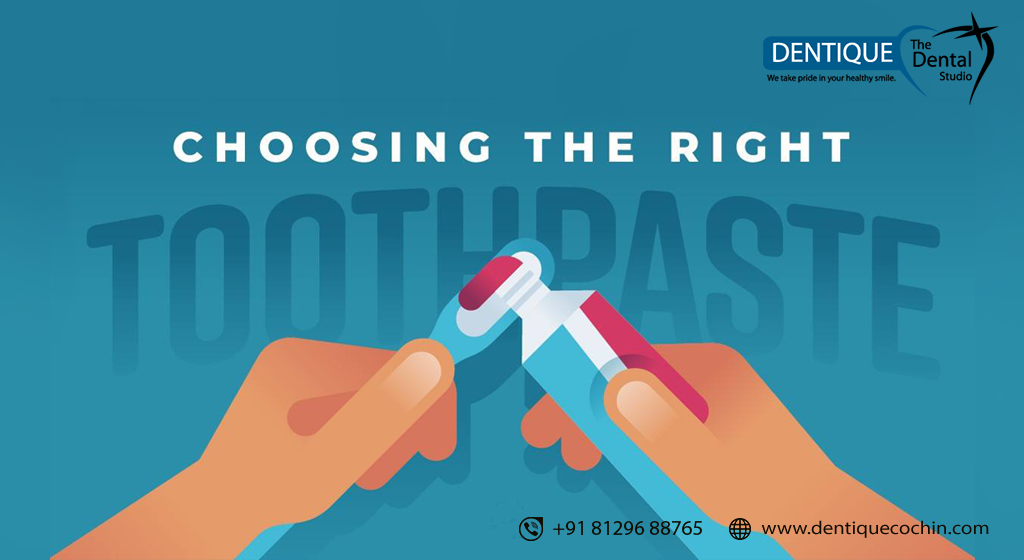
VISITING HOURS:
Week Days - 9 am to 8 pmSundays - Only Emergency Cases
Ultimate Guide for Choosing the Right Toothpaste
This blog will help you weigh the pros and cons of the different toothpaste available and help you pick the best toothpaste suitable for you.
Toothpaste is generally considered a basic necessity of the modern world. Most of us take it for granted that we should brush our teeth two or three times a day in order to promote dental health. However, the question in every user’s mind when they go to the supermarket to buy this wonderful product is –
Which one should I buy?
We have oral cleaning products in different forms of tooth gel, toothpaste, and toothpowder. Formulations with salt, charcoal-activated beads, whitening properties, de-sensitizing, ayurvedic, different colors, flavors, for kids, adults, and so on and so forth. Thus choosing a simple product like toothpaste is quite a daunting task, especially with the numerous advertising claims made by various brands. The only thing you can do is to thoroughly understand the facts behind the hype and make a knowledgeable decision on which toothpaste to purchase for you and your family members. Also, visit the best dental clinic for proper check-ups.
What is toothpaste really made of?
To know which toothpaste to buy, let us first understand – What is the function of toothpaste?
If you tap the surface of the tooth, you hear a very specific sound, much akin to what you would hear if you tap a solid wooden surface. Yes, the tooth seems rock solid, in fact, it is made of a porous material called enamel. Enamel is the hardest tissue in the human body, even stronger than the bone and its function is to protect the teeth. But then the question arises – Why it is so prone to cavities?
The bacteria that are inherently present in your mouth transform food into sticky plaque which sticks to the enamel. The acid that is secreted from this plaque gradually corrodes it away unless you remove the plaque with toothpaste and a toothbrush. Much like what would happen if you pour acid onto a beautiful Italian marble – it would be destroyed. The role of toothpaste is plain and simple – to scrub out the cavities and plaque and clean your teeth without harming the enamel.
How Should You Choose Your Toothpaste?
Just like you would not use a shampoo prescribed for oily hair type on dry hair, toothpaste also is many, each catering to a different problem. Selecting the wrong toothpaste is quite a worrisome issue, as they may have some ingredients that can harm your teeth, while others simply won’t be enough to protect your teeth. You should especially be wary of those sold as cosmetic products rather than medically tested and approved toothpaste. While all the products on the shelf might seem the same, with a little help from your dentist you can determine which toothpaste is right for you. Toothpaste comes in gel and pastes formulations. Choosing between the two is merely just a matter of personal preferences. This is because they have the same ingredients and work in the same way.
Most toothpaste tends to target one or more of the following conditions or needs. Here are some options to consider when selecting a toothpaste, however, note that for more severe cases treatments at the dentist are a must.
- Anti-cavity Toothpaste: Fluoride makes the enamel of your teeth harder and more resistant to acid wear. This mineral is key to fighting tooth decay as it actively strengthens tooth enamel. Almost all toothpaste contains fluoride. In fact, fluoridated toothpaste will help restore enamel that has not yet decayed. However please note that if fluoride is already present in your drinking water, you do not need fluoride toothpaste. Research has shown that excessive use of fluoride discolors teeth and causes white patches. Please note that the equivalent treatments available at the dentist are – Sealants and Fluoride applications.
- Bleeding Gums or Gingivitis: Do your gums suffer from redness and bleeding? You might have gingivitis, a mild form of gum disease. Toothpaste for bleeding gums helps reduce oral bacteria and can be very effective at stopping this gum condition at its source. If the toothpaste does not yield results even after using it for a month it is time for your visit to the dentist. Treatment available at the dentist for gum problems is Deep Scaling which involves removing plaque and tartar from not only the surface of the teeth but also from the pocket areas between the teeth and gums.
- Sensitive Teeth: Ever take a sip of a hot tea or a cold coffee and feel a shooting pain? Desensitizing toothpaste might be the key to your relief. It helps reduce pain by blocking the tooth’s pain signal to the nerve. This, however, may be only helpful for pain that is mild in nature. For a more severe situation, a visit to the dentist is a must. Treatments available at the dentist for sensitive teeth are – Tooth Fillings and Desensitising Dental Lacquer.
- Tartar-control: As its name indicates, tartar-control toothpaste helps to prevent the build-up of tartar–hardened plaque. To prevent tartar use toothpaste with a pyrophosphate formulation. While this product is helpful in slowing new build-up on teeth, professional dental cleaning or Scaling is the only way to remove existing tartar and the bacteria it harbors.
- Whitening: A whitening toothpaste helps to prevent surface stains that cause discoloration. These contain either polishing agents (ranging from natural walnut shells to plastic microbeads) or chemical agents (sodium hexametaphosphate, carbamide peroxide, or hydrogen peroxide). Some even have activated charcoal powders. These toothpastes help you to maintain the natural color of your teeth. However, if used for a long time it can cause sensitivity and loss of enamel which is permanent and hard to treat. It’s best to avoid whitening toothpaste especially if you have sensitive teeth. These chemical agents may cause irritation or a worsening of your symptoms. Please note that whitening toothpaste can’t always replace professional whitening from a dentist.
OUR
TREATMENTS
TREATMENTS








